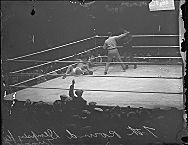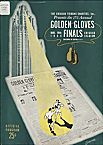| Entries |
| B |
|
Boxing
|

|
Boxing flourished in the late 1890s at Tattersall's at 16th and Dearborn. A match there between famed champion Bob Fitzsimmons and Englishman Jim Thorne was the first prizefight in the city to attract an upper-class clientele. Following a rigged boxing match between Terry McGovern and Joe Gans in December of 1900, prizefighting was banned in the city early in 1901, a ban upheld for more than a quarter century. Amateur matches continued to be held in the city, however, by such organizations as the Chicago Athletic Association (CAA).

|

|

|
In 1949, boxing promoter James Norris and Chicago Stadium owner Arthur Wirtz formed the International Boxing Club, which controlled pro boxing competition before being broken up by the federal government as a monopoly in 1957. During that time the Chicago Stadium played host to many of the biggest fights in the country, featuring such boxers as Sugar Ray Robinson, Rocky Marciano, and Floyd Patterson. In 1961, Wirtz ended boxing matches at the Stadium, and thereafter Chicago declined as a boxing town.
Since the early 1960s, boxing in the city has been basically a club sport, with fight cards featuring local boxers holding matches in hotels, many promoted by former heavyweight champion Ernie Terrell (a product of the West Side). The premier private gym in the city since the late 1970s has been the Windy City Boxing Club, producing such fighters as Andrew Golota and Angel Manfredy. In 1994, the Golden Gloves opened the tournament to women.
The Encyclopedia of Chicago © 2004 The Newberry Library. All Rights Reserved. Portions are copyrighted by other institutions and individuals. Additional information on copyright and permissions.